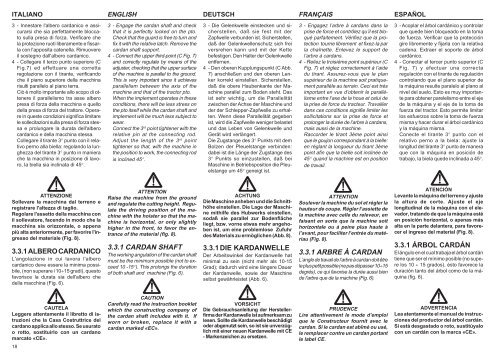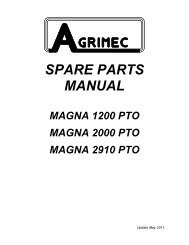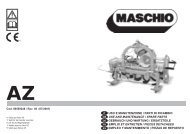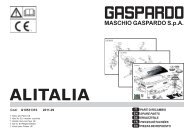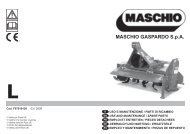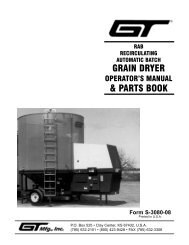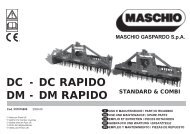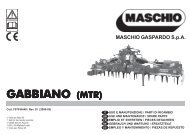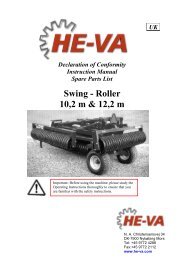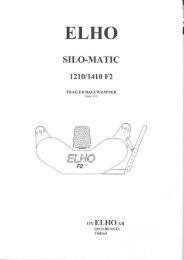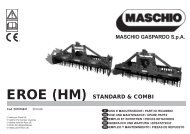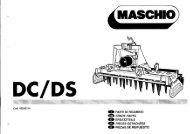uso e manutenzione / parti di ricambio use and maintenance ... - Opico
uso e manutenzione / parti di ricambio use and maintenance ... - Opico
uso e manutenzione / parti di ricambio use and maintenance ... - Opico
Create successful ePaper yourself
Turn your PDF publications into a flip-book with our unique Google optimized e-Paper software.
ITALIANO ENGLISH DEUTSCH FRANÇAIS<br />
ESPAÑOL<br />
3 - Innestare l'albero cardanico e assicurarsi<br />
che sia perfettamente bloccato<br />
sulla presa <strong>di</strong> forza. Verificare che<br />
la protezione ruoti liberamente e fissarla<br />
con l'apposita catenella. Rimuovere<br />
il sostegno dall'albero cardanico.<br />
4 - Collegare il terzo punto superiore (C<br />
Fig.7) ed effettuare una corretta<br />
regolazione con il tirante, verific<strong>and</strong>o<br />
che il piano superiore della macchina<br />
risulti parallelo al piano terra.<br />
Ciò è molto importante allo scopo <strong>di</strong> ottenere<br />
il parallelismo tra asse albero<br />
presa <strong>di</strong> forza della macchina e quello<br />
della presa <strong>di</strong> forza del trattore. Operare<br />
in queste con<strong>di</strong>zioni significa limitare<br />
le sollecitazioni sulla presa <strong>di</strong> forza stessa<br />
e prolungare la durata dell'albero<br />
cardanico e della macchina stessa.<br />
Collegare il tirante 3° punto con il relativo<br />
perno alla biella: regol<strong>and</strong>o la lunghezza<br />
del tirante 3° punto in maniera<br />
che la macchina in posizione <strong>di</strong> lavoro,<br />
la biella sia inclinata <strong>di</strong> 45°.<br />
ATTENZIONE<br />
Sollevare la macchina dal terreno e<br />
registrare l'altezza <strong>di</strong> taglio.<br />
Regolare l'assetto della macchina con<br />
il sollevatore, facendo in modo che la<br />
macchina sia orizzontale, o appena<br />
più alta anteriormente, per favorire l'ingresso<br />
del materiale (Fig. 8).<br />
3.3.1 ALBERO CARDANICO<br />
L'angolazione in cui lavora l'albero<br />
cardanico deve essere la minima possibile,<br />
(non superare i 10÷15 gra<strong>di</strong>), questo<br />
favorisce la durata sia dell'albero che<br />
della macchina (Fig. 6).<br />
CAUTELA<br />
Leggere attentamente il libretto <strong>di</strong> istruzioni<br />
che la Casa Costruttrice del<br />
cardano applica allo stesso. Se usurato<br />
o rotto, sostituirlo con un cardano<br />
marcato «CE».<br />
18<br />
3 - Engage the cardan shaft <strong>and</strong> check<br />
that it is perfectly locked on the pto.<br />
Check that the guard is free to turn <strong>and</strong><br />
fix it with the relative latch. Remove the<br />
cardan shaft support.<br />
4 - Connect the upper third-point (C Fig. 7)<br />
<strong>and</strong> correctly regulate by means of the<br />
adjuster, checking that the upper surface<br />
of the machine is parallel to the ground.<br />
This is very important since it achieves<br />
parallelism between the axis of the<br />
machine <strong>and</strong> that of the tractor pto.<br />
When the implement operates in these<br />
con<strong>di</strong>tions, there will be less stress on<br />
the pto itself while the cardan shaft <strong>and</strong><br />
implement will be much less subject to<br />
wear.<br />
Connect the 3 rd point tightener with the<br />
relative pin at the connecting rod.<br />
Adjust the length of the 3 rd point<br />
tightener so that, with the machine in<br />
the position to work, the connecting rod<br />
is inclined 45°.<br />
ATTENTION<br />
Raise the machine from the ground<br />
<strong>and</strong> regulate the cutting height. Regulate<br />
the driving position of the machine<br />
with the hoister so that the machine<br />
is horizontal, or only slightly<br />
higher in the front, to favor the entrance<br />
of the material (fig. 8).<br />
3.3.1 CARDAN SHAFT<br />
The working angulation of the cardan shaft<br />
must be the minimum possible (not to exceed<br />
10 -15°). This prolongs the duration<br />
of both shaft <strong>and</strong> machine (Fig. 6).<br />
CAUTION<br />
Carefully read the instruction booklet<br />
which the constructing company of<br />
the cardan shaft includes with it. If<br />
worn or broken, replace it with a<br />
cardan marked «EC».<br />
3 - Die Gelenkwelle einstecken und sicherstellen,<br />
daß sie fest mit der<br />
Zapfwelle verbunden ist. Sicherstellen,<br />
daß der Gelenkwellenschutz sich frei<br />
versrehen kann und mit der Kette<br />
befestigen. Den Halter der Gelenkwelle<br />
entfernen.<br />
4 - Den oberen Kupplungspunkt (C Abb.<br />
7) anschließen und den oberen Lenker<br />
korrekt einstellen. Sicherstellen,<br />
daß <strong>di</strong>e obere Haubenkante der Maschine<br />
parallel zum Boden steht. Das<br />
ist sehr wichtig, um <strong>di</strong>e Parallelität<br />
zwischen der Achse der Maschine und<br />
der der Schlepper-Zapfwelle zu erhalten.<br />
Wenn <strong>di</strong>ese Parallelität gegeben<br />
ist, wird <strong>di</strong>e Zapfwelle weniger belastet<br />
und das Leben von Gelenkwelle und<br />
Gerät wird verlängert.<br />
Die Zugstange des 3° Punkts mit dem<br />
Bolzen der Pleuelstange verbinden:<br />
dabei ist <strong>di</strong>e Länge der Zugstange des<br />
3° Punkts so einzustellen, daß bei<br />
Maschine in Betriebsposition <strong>di</strong>e Pleuelstange<br />
um 45° geneigt ist.<br />
ACHTUNG<br />
Die Maschine anheben und <strong>di</strong>e Schnitthöhe<br />
einstellen. Die Lage der Maschine<br />
mithilfe des Hubwerks einstellen,<br />
sodaß sie parallel zur Bodenfläche<br />
liegt, bzw. vorne etwas mehr angehoben<br />
ist, um eine problemlose Zufuhr<br />
des Materials zu ermöglichen (Abb. 8).<br />
3.3.1 DIE KARDANWELLE<br />
Der Arbeitswinkel der Kardanwelle hat<br />
minimal zu sein (nicht mehr als 10-15<br />
Grad); dadurch wird eine längere Dauer<br />
der Kardanwelle, sowie der Maschine<br />
selbst gewährleistet (Abb. 6).<br />
VORSICHT<br />
Die Gebrauchsanleitung der Herstellerfirma<br />
der Kardanwelle ist aufmerksam zu<br />
lesen. Sollte <strong>di</strong>e Kardanwelle beschä<strong>di</strong>gt<br />
oder abgenutzt sein, so ist sie unverzüglich<br />
mit einer neuen Kardanwelle mit CE<br />
- Markenzeichen zu ersetzen.<br />
3 - Engagez l’arbre à cardans dans la<br />
prise de force et contrôlez qu’il est bloqué<br />
parfaitement. Vérifiez que la protection<br />
tourne librement et fixez-la par<br />
la chaînette. Enlevez le support de<br />
l’arbre à cardans.<br />
4 - Reliez le troisième point supérieur (C<br />
Fig. 7) et réglez correctement à l’aide<br />
du tirant. Assurez-vous que le plan<br />
supérieur de la machine soit pratiquement<br />
parallèle au terrain. Ceci est très<br />
important en vue d’obtenir le parallélisme<br />
entre l’axe de la houe et celui de<br />
la prise de force du tracteur. Travailler<br />
dans ces con<strong>di</strong>tions signifie limiter les<br />
sollicitations sur la prise de force et<br />
prolonger la durée de l’arbre à cardans,<br />
mais aussi de la machine.<br />
Raccorder le tirant 3ème point ainsi<br />
que le goujon correspondant à la bielle:<br />
en réglant la longueur du tirant 3ème<br />
point afin que la bielle soit inclinée de<br />
45° qu<strong>and</strong> la machine est en position<br />
de travail.<br />
ATTENTION<br />
Soulever la machine du sol et régler la<br />
hauteur de coupe. Régler l’assiette de<br />
la machine avec celle du releveur, en<br />
faisant en sorte que la machine soit<br />
horizontale ou à peine plus haute à<br />
l’avant, pour faciliter l’entrée du matériau<br />
(Fig. 8).<br />
3.3.1 ARBRE À CARDAN<br />
L’angle de travail de l’arbre à cardan doit être<br />
le plus petit possible (ne pas dépasser 10÷15<br />
degrés), ce qui favorise la durée aussi bien<br />
de l’arbre que de la machine (Fig. 6).<br />
PRUDENCE<br />
Lire attentivement le mode d’emploi<br />
que le Constructeur fournit avec le<br />
cardan. Si le cardan est abîmé ou usé,<br />
le remplacer contre un cardan portant<br />
le label CE.<br />
3 - Acoplar el árbol cardánico y controlar<br />
que quede bien bloqueado en la toma<br />
de fuerza. Verificar que la protección<br />
gire libremente y fijarla con la relativa<br />
cadena. Extraer el soporte de árbol<br />
cardánico.<br />
4 - Conectar el tercer punto superior (C<br />
Fig. 7) y efectuar una correcta<br />
regulación con el tirante de regulación<br />
control<strong>and</strong>o que el plano superior de<br />
la máquina resulte paralelo al plano al<br />
nivel del suelo. Esto es muy importante<br />
para obtener parelelismo entre el eje<br />
de la máquina y el eje de la toma de<br />
fuerza del tractor. Esto permite limitar<br />
los esfuerzos sobre la toma de fuerza<br />
misma y hacer durar el árbol cardánico<br />
y la máquina misma.<br />
Conecte el tirante 3° punto con el<br />
relativo perno a la biela: ajuste la<br />
longitud del tirante 3° punto de manera<br />
que con la máquina en posición de<br />
trabajo, la biela quede inclinada a 45°.<br />
ATENCIÓN<br />
Levante la máquina del terreno y ajuste<br />
la altura de corte. Ajuste el eje<br />
longitu<strong>di</strong>nal de la máquina con el elevador,<br />
trat<strong>and</strong>o de que la máquina esté<br />
en posición horizontal, o apenas más<br />
alta en la parte delantera, para favorecer<br />
el ingreso del material (Fig. 8).<br />
3.3.1 ÁRBOL CARDÁN<br />
El ángulo en el cual trabaja el árbol cardán<br />
tiene que ser el mínimo posible (no supere<br />
los 10 ÷ 15 grados), ésto favorece la<br />
duración tanto del árbol como de la máquina<br />
(fig. 6).<br />
ADVERTENCIA<br />
Lea atentamente el manual de instrucciones<br />
del productor del árbol cardán.<br />
Si está desgastado o roto, sustitúyalo<br />
con un cardán con la marca «CE».


